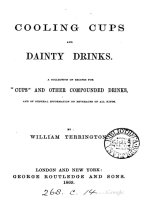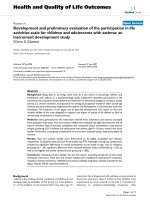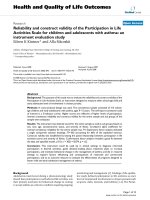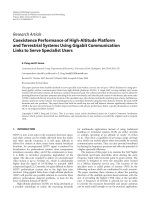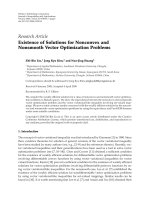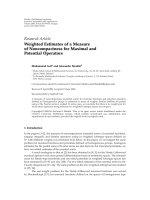fluid dynamics of packed columns principles of the fluid dynamic design of columns for gasliquid and liquidliquid systems
Bạn đang xem bản rút gọn của tài liệu. Xem và tải ngay bản đầy đủ của tài liệu tại đây (14.13 MB, 368 trang )
Jerzy Ma
´
ckowiak
Fluid Dynamics of Packed Columns
Jerzy Ma
´
ckowiak
Fluid Dynamics
of Packed Columns
Principles of the Fluid Dynamic Design of Columns for
Gas/Liquid and Liquid/Liquid Systems
Translated by Claudia Hall
with the cooperation of Anna Ługowska-Czok
123
Dr Ing. Jerzy Ma
´
ckowiak
ENVIMAC Engineering GmbH
Im Erlengrund 27
46149 Oberhausen
Germany
ISBN 978-3-540-88780-5 e-ISBN 978-3-540-88781-2
DOI 10.1007/b98397
Springer Heidelberg Dordrecht London New York
Library of Congress Control Number: 2009926972
© Springer-Verlag Berlin Heidelberg 2010
This work is subject to copyr ight. All rights are reserved, whether the whole or part of the material is
concerned, specifically the rights of translation, reprinting, reuse of illustrations, recitation, broadcasting,
reproduction on microfilm or in any other way, and storage in data banks. Duplication of this publication
or parts thereof is permitted only under the provisions of the German Copyright Law of September 9,
1965, in its current version, and permission for use must always be obtained from Springer. Violations
areliabletoprosecutionundertheGermanCopyrightLaw.
The use of general descriptive names, registered names, trademarks, etc. in this publication does not
imply, even in the absence of a specific statement, that such names are exempt from the relevant protective
laws and regulations and therefore free for general use.
Cover design:WMXDesignGmbH,Heidelberg
Printed on acid-free paper
Springer is part of Springer Science+Business Media (www.springer.com)
Foreword by Prof. Górak, Technical University of Dortmund
Columns for distillation, absorption and extraction have been applied for years in chem-
ical, petrochemical, food, energy and electronic industry. They are often equipped with
different kinds of packings. Understanding of principles for packing design, internal traf-
fic of phases within the column and implementing of theoretical models into indus-
trial practice is of vital interest of both – students and practitioners. The book of
Dr. J. Ma
´
ckowiak gives a deep insight into the fluid dynamics of packed columns. It is
based on personal experience of the author and on a tremendous experimental data base
on pressure drop (10,000 points), flooding points (1,2000 points) and liquid hold-up
(1,100 points) measured for about 200 different types of random and structured pack-
ings. This is the biggest experimental data base published ever.
Thebigvalueofthisbookisalsothetheoreticalmodel,called“SuspendedBedof
Droplets” which is bases on the dependency between the flow resistance coefficient and
packing shape. This model is predictive, i.e. it allows calculation of pressure drop and
flooding gas velocity for unknown packing geometry. The model is valid for pressures
from vacuum up to 100 bar and for specific liquid loads up to 250 m
3
m
–2
h
−1
.Inthis
book the reader will find the sound theoretical analysis of two phase flow in packed
column, extensive correlation of existing data for traditional and modern packings as
well as pr actical equations which can be directly used in academic teaching courses and
industrial applications.
Dr. J. Ma
´
ckowiak has committed to paper his 20 years experience as practitioner while
operating company ENVIMAC GmbH and a s researcher, publishing his results in jour-
nals and conference papers. Calculation methods of packed columns, presented in the
book will increase the design accuracy of distillation, absorption and extraction which
cause up to 60% of total processing costs in chemical industry.
Dortmund, February 2009 Prof. Dr Ing. A. Górak
Technical University of Dortmund
Department of Biochemical and Chemical Engineering
Laboratory of Fluid Separations
University of Munich
For many years now, packed columns have been used in various domains, such as dif-
fusional separation technology, environmental technology and biotechnology, providing
a mass transfer contact area for gases and liquids. In recent decades, scientific a s well as
economic factors have continually led to new and more efficient packings being designed.
The industry is striving to accurately dimension modern packings made with new mate-
rials and innovative geometric designs and to operate them in a reliable manner. This
requires first of all the compilation and general presentation of experimental data, a dif-
ficult and time-consuming task, which the author has been undertaking for many years.
This work is based on more than 10,000 experimental pressure drop data, in excess
of 1,100 liquid hold-up data and more than 1,200 flooding point data for approx. 160
different random and structured packings made of various materials commonly used
in practice. The majority of this data was compiled by the author in an accurate and
reproducible manner whilst working for the Institute of Thermal Separation Processes at
Bochum University. This book exceeds all publications worldwide in terms of its volume
of data, and the industry will b e grateful to the author as well as Springer Publishing for
its publication.
It is my hope and wish that, for the benefit of mankind, the comprehensive and accu-
rate results and conclusions of this work will lead to an improvement in the design and
operationofpackedcolumns.
Alfons Mersmann
ThefirstGermaneditionofthebook“Fluiddynamicsofpackedcolumnswithmodern
random and structured packings for gas/liquid systems” was published in 1991. It sold
out within a few years. Added to this were numerous enquiries, in particular within the
industry, prompting me to publish a second, extended edition.
A packed column remains the core element of any diffusional separation process. This
underlines the need for basic design principles for packed columns, which enhance the
design process by making it more accurate and reliable.
The SBD (suspended bed of droplets) model introduced in the first German edition
of the book was well received by the experts and is now used by a large number of compa-
nies in the industry, as it offers improved reliability in the fluid dynamic design of packed
columns. For the purpose of facilitating the design process, the SBD model was inte-
grated into the simulation programme ChemCAD. The software programme FDPAK,
which is available for Windows, has certainly contributed to the widespread use of the
SBD model. The programme is very user-friendly and the calculation results are pre-
sented in tabular as well as graphic form, showing flood load, pressure drop and hold-up
diagrams in the entire operating range.
The first German edition concentrates on the description of the fluid dynamics of
columns with random and structured packings in the vacuum and normal pressure range
of up to approx. 2 bar and for specific liquid loads of up to 100 m
3
m
−2
h
−1
for gas-
liquid systems. This range covers a majority of the applications and tasks relevant in
the absorption and desorption of highly and/or moderately soluble gases as well as in
rectification under vacuum and normal pressure.
The importance of absorption and rectification under high pressure has steadily
increased in the past 10 years, calling for an upgrading of the existing model. Fortunately,
new publications emerged during the last 15 years, presenting experimental data on pres-
sure drop, flooding point and hold-up parameters for high-pressure systems. Based on
this, it was possible to and expand the validity of the correlation derived in the first Ger-
man edition for determining the hold-up at flooding point to include the range of high
liquid loads and therefore higher hold-up parameters (Chap. 2).
Using the SBD model, it is now possible to describe operations under higher pressure,
which is ver y significant in practice, as it is linked to high liquid loads and low gas veloc-
ities. The SBD model has been verified using experimental data taken at hig h pressure of
x Preface
up to 100 bar. There are some practical numerical examples at the end of each chapter,
which provide an insight into the application of the model.
The current edition will introduce a generally valid procedure of the single pressure
drop calculating based on the knowledge of the form factor (P and an additional model
for calculating the pressure drop of irrigated structured and random packings, based on
the knowledge of the law of resistance ψ
LV
=f(Re
L
) for two-phase counter-current flows
and of the liquid hold-up h
L
0
in the entire operating range up to flooding point. This
model is suitable for applications, in which the only available data for determining the
law of resistance is experimental pressure drop data for a two-phase system (no given
pressure drop data for dry random packings), or in which the pressure drop above the
loading line for low viscous mixtures needs to be determined more accurately.
A large amount of experimental data has shown that this model generates satisfac-
tory results up to flooding point for laminar Re
L
< 2 as well as for turbulent liquid flow
Re
L
>2.
The correlation for determining the gas velocity at flooding point introduced in the
first edition has been modified further and can now also be applied to any type of struc-
tured packing, tube columns with regularly stacked Pall rings, Hiflow rings and Białecki
rings and regularly stacked layers of Pall rings, Raschig r ings, Hiflow rings and Białecki
rings. Following the latest findings, it has been possible to mathematically compute vari-
ous loading capacities of structured column internals of types X and Y with flow channels
at different gradients. This has also been taken into account in the expanded general cor-
relation for calculating the gas velocity at flooding point, which makes this correlation
applicable to any type of column internal.
Chapter 7 introduces for the first time the basic fluid dynamics principles of
packed columns for liquid/liquid extraction. The previously mentioned SBD model for
gas/liquid systems is transferable to liquid/liquid systems. The m ethod used to calculate
the gas velocity at flooding point of the disperse and continuous phases will be explained
by means of some numerical examples.
The guiding idea behind this book was to develop a closed, consistent concept for
designing packed columns for gas/liquid and liquid/liquid systems, in order to make the
calculation of individual parameters more transparent and create a basis for objective
comparisons between different column internals.
In contrast to other studies, this book uses a different approach for logging processes
within packed columns, which is based on the specific flow behaviour of droplet systems.
The occurrence of droplet systems in packed columns was confirmed by Bornhütter
and Mersmann in 1991. Hence, despite the highly complicated processes of two-phase
flows in packed columns, it was possible to form straig ht-forward, user-friendly correla-
tions, which are ideal for practical applications when it comes to developing solutions for
a wide range of tasks. The simple correlations are particularly advantageous when com-
paring a large number of different columns internals. In addition, this book should help
scientists as well as students to gain a better understanding of flow processes in gas/liquid
and liquid/liquid systems.
As opposed to other studies, this book draws on the publications of other authors to
support and expand the application ranges of the SBD model. However, it does not use
Preface xi
them for the illustration and comparison of different calculation models. This work is
based on more than 10,000 experimental pressure drop data, in excess of 1,200 flood-
ing point data and approx. 1,100 liquid hold-up data for nearly 200 different types of
packings. Compared to the 1st edition, the figures have more or less doubled.
What is particularly significant from a scientific point of view, is the knowledge that
the experimental work and test systems under vacuum and high pressure previously
required for the research and development of new types of column design can be reduced
to just a few steps, thus allowing the user to determine the model parameters of the SBD
model fast and with minimal experimental effort using the air/water test system. It is
worth noting that tests using single-phase air flows under ambient conditions are suffi-
cient to determine the system-independent law of resistance ψ = f(Re
V
).Inthecaseof
simple types of packing, it is possible to determine the resistance factor of single-phase
flow simply based on the geometric configuration without requiring experimental evi-
dence, as described in Chap. 3. It is therefore possible to transfer the entire fluid dynamics
of one type of column internal to any application in diffusional separation technology.
J. Ma´ckowiak
Summary
For many years now, there has been a constant demand for low pressure drop column
internals in rectification, absorption, stripping and liquid/liquid extraction. The prevail-
ing trend in the chemical industry is to replace tray columns with those containing mod-
ern structured and random packings. When planning the design of packed columns, it
therefore particularly important to use reliable methods for predicting the mass transfer
and hydrodynamic behaviour of the two-phase flow.
For this reason, the book is aimed at illustrating the basic principles of the fluid
dynamic design of columns with modern random and structured packings, using a new
design concept which can be applied to any type of packing.
One of the author’s priorities was the practical aspect of the work, since the standard
approach to rectification, absorption and extraction as the core areas of thermal process
engineering is purely empirical.
The design data for gas/liquid and liquid/liquid systems presented in the current edi-
tion are strongly interlinked and based on the SBD model for both systems.
The design process for gas/liquid systems is based on correlations which have been
experimentally derived and verified. The process allows the calculation of the flooding
point, pressure drop and hold-up for gas/liquid systems virtually in the entire operating
range up to flooding point. The following features of the process should be highlighted:
The model parameters are calculated for a given packing density using the water/air
system under normal conditions. The experiments conclude that these model parameters
for the separation of mixtures in rectification technology in the vacuum to high pressure
range are applicable for the entire operating range. Hence, the experimental work can be
minimised to just a few steps using only the air/water system under normal conditions.
The model also allows the calculation of flooding point and hold-up parameters for
liquid/liquid systems virtually in the entire operating range up to flooding point.
Structure
The content of this book is divided into seven chapters. The first six chapters deal with
gas/liquid systems (Part 1); Chapter 7 is dedicated to liquid/liquid extraction. The struc-
ture of the first five chapters largely matches the calculation steps applied in the fluid
dynamic design of packed columns for gas/liquid systems. Chapter 1 briefly describes
the structure of packed columns and their significance for the separation of mixtures
under vacuum conditions as well as for absorption and desorption. It also outlines the
design processes commonly used today. This is followed by an analysis of the hydraulic
behaviour of packed columns and their relevant parameters, with Chap. 2 examining
the flooding point of the lower operating range and Chap. 3 determining the pressure
drop of dry random packings. Chapters 4 and 5 deal with the pressure drop of irrigated
random packings and their liquid hold-up parameters.
The correlations derived in Chaps. 2, 3 and 4 can be used to calculate the apparatus
diameter and determine the pressure drop and liquid hold-up in a given operating range
and at flooding point.
For the purpose of illustrating the topics, each chapter begins with a brief overview of
the most relevant work on the respective topic as judged by the author, followed by the
presentation of the chosen approach.
The results of this work are summarised in Chap. 6. The Tables 6-1a–c contain the
geometric column data, such as packing density N
0
, specific geometr ic surface of packing
elements a
0
,voidfractionε
0
,specificweightGof1m
3
according to the manufacturer.
In addition, the chapter contains all numerical values of the parameters required for the
fluid dynamic design of approx. 200 randomly and regularly stacked packing elements
well as tube columns and structured packings.
By using the equations derived for the calculation of each parameter, it was possible
to condense the extensive research material, which is discussed in the summary of the
results of this work in Chap. 6. The end of each chapter contains example calculations
to illustrate the individual correlations for determining the vapour load factor at the
flooding point of the liquid hold-up as well as the pressure drop of irrigated and dry
random packing elements. The numerical examples are practice-oriented and explain
the correlations mentioned before, based on the examples of different packings.
The references relating to the individual chapters are listed at the end of each chapter.
The book boasts comprehensive tables and charts with information on experimental
data and test conditions, highlighting the enormous volume of tests as well as the scope
xvi Structure
of application offered by this process. Following Chap. 6 is a description of FDPAK, the
well-known and extensively used software programme for the fluid dynamic design of
packed columns.
The correlations most commonly used in this work are compiled and explained in a
separate list of symbols at the beginning of the book.
The first German edition of the book was written between 1988 and 1990 and the
second one evolved between 1997 and 2002. The first English addition is based on exper-
imental data stemming from more than 200 – mostly modern – random and structured
packings between 1965 and 2008.
The tests were mainly carried out by the author using distillation plants with diam-
eters d
S
of 0.15/0.22/0.5 m and absorption plants with diameters of 0.15/0.22/0.3 m and
0.45/0.6 m as well as industrial plants with diameters of 0.8/1.2/1.6/1.8/3 m owned
by ENVIMAC Engineering GmbH. A considerable amount of test data on rectifica-
tion (d
S
= 0.5 m) and absorption (d
S
= 0.3 m) originates from the author’s work as
Scientific Assistant at the Institute for Chemical Engineering, Technical University of
Wrocław/Polen (1970–1976). In co-operation with Dr. Ing. S. Filip, Dr. Ing. Z. Ługowski,
Dr. Ing. S. Suder and Dr. Ing. habil. A. Kozioł from the Technical University of Wrocław,
the author carried out a number of studies on modern packings at industrial plants,
which are also referred to in this monograph. Some of the test results, in particu-
lar the rectification data for metal Pall rings (15–80 mm), stem from the findings of
Prof. Billet. Further test data on extraction and rectification processes were taken from
a number of scientific studies, which were personally conceived and overseen by the
author at the Institute for Thermal Separation Processes at Bochum University, under
Prof. Dr. Ing. R. Billet.
In 1990, a database was created for the purpose of evaluating all experimental data,
including literature data. It currently holds more than 1,200 experimental flooding point
data, in excess of 1,100 liquid hold-up data and more than 10,000 pressure drop data for
irrigated random and structured packings. The number of test mixtures is 32. The result
is a comprehensive data pool, which is constantly being updated with the addition of
new exper imental data.
The progress in terms of the accuracy in desig ning packed columns for gas/liquid
and liquid/liquid system is considerable. The results of this work have led to accurate
predictions of the fluid dynamic behaviour of random packing elements, simply based
on their geometric form without requiri ng any chemical engineer i ng tests.
Acknowledgments
A special thank you goes to Prof. Dr. Ing. A. M ersmann, Technical University of Munich,
for many fruitful discussions and valuable suggestions for the draft of the first German
edition, Prof. Dr Ing. A. Górak, Technical University of Dortmund, for reviewing the first
Englishedition,aswellastomyfriendProf. Dr. Ing. habil. A. Kozioł, Technical University
of Wrocław and Dr.Ing.J.Szust, ENVIMAC Engineering GmbH, for his contribution
towards the development of the FDPAK programme and evaluating the flooding point
data.
My son, Dipl. Ing. Jan Ma´ckowiak, proof-read the second German edition thoroughly
and converted it to the correct format for printing.
Mrs Dipl. Ing. Anna Ługowska-Czok prepared the first English edition for printing and
produced the complex graphs showing flooding point and pressure drop parameters in
order to illustrate the spread of the experimental data.
I would also like to thank Mrs Claudia Hall for the translation of this book as well as
her co-operation and valuable contributions to the English edition.
I would particularly like to thank my wife Nathalie and my c hildren Jan and Anna for
their patience, and all those who have supported me in writing this book.
Jerzy Ma´ckowiak, 2009
Contents
Part 1
Principles of the Fluid Dynamic Design of Packed Columns for Gas/Liquid Systems
1 Introduction 11
1.1 GeneralInformationonPackedColumns 11
1.2 Development of Packed Columns and Their Significance in
RectificationandAbsorptionTechnology 14
1.3 Brief Overview of Existing Monographs and/or Complex Reviews on
PackedColumnDesign 17
1.4 ConclusionChapter1 21
2 Two-Phase Flow and Operating Range 25
2.1 HydraulicProcessesinPackedColumns 25
2.2 FloodingPoint 29
2.2.1 FloodingMechanisms 29
2.2.2 DropletFormationinPackedColumns 31
2.2.3 LiteratureOverview–StatusofKnowledge 34
2.2.4 NewModelofSuspendedBedofDroplets(SBD)for
Determining Gas Velocity u
V,Fl
atFloodingPoint 44
2.2.5 ConclusionsChapter2.2 88
2.3 DeterminingColumnDiameter 93
2.4 LowerLoadingLine 93
2.4.1 ConclusionsSection2.4 94
3 Pressure Drop of Dry Packed Columns 123
3.1 Introduction 123
3.2 LawofResistanceforSingle-PhaseFlowinPackedColumns 123
3.2.1 Determining the Resistance Coefficient ψ forPallRings 127
3.2.2 Determining the Resistance Coefficient for Other Random
Packings 131
3.2.3 Determining the Resistance Coefficient ψ for Structured
Packings 133
xx Contents
3.3 Introducing a Channel Model Based on Partially Perforated Channel
Walls 140
3.3.1 Determining the Resistance Coefficient for Non-perforated
PackingElements 142
3.3.2 Determining the Pressure Drop in Single-Phase Flow – Final
Equation 143
3.3.3 EvaluationofResults 143
3.4 ConclusionsChapter3 145
4 Pressure Drop of Irrigated Random and Structured Packings 175
4.1 IntroductionandLiteratureOverview 175
4.1.1 SignificanceofPressureDropforPackedColumnDesign 175
4.1.2 LiteratureOverview 176
4.2 LiquidHold-Up 183
4.2.1 BasicTerms 184
4.2.2 StaticLiquidHold-Up 184
4.2.3 DynamicLiquidLoadBelowtheLoadingLine 185
4.2.4 Analysing the Influence of Various Parameters on Liquid
Hold-Up,BasedonLiteratureData 188
4.2.5 TestMethod,SystemsandPackingElements 190
4.2.6 ExperimentalResults 190
4.2.7 ConclusionsSection4.2 204
4.3 Model for Determining the Pressured Drop of Irrigated Random and
Structured Packings, Based on the Known Resistance Coefficient ψ for
Single-Phase Flow and the Dimensionless Pressure Drop p/p
0
207
4.3.1 DerivingtheModel 207
4.3.2 Comparing Calculated and Experimental Values for Laminar
Liquid Flow, Re
L
<2 209
4.3.3 Determining the Parameter C
B
forTurbulentLiquidFlow 211
4.3.4 Comparing Calculated and Experimental Values for Turbulent
LiquidFlow 214
4.3.5 ConclusionsSection4.3 223
5 Pressure Drop of Irrigated Random and Structured Packings Based on the
Law of Resistance for Two-Phase Flow 247
5.1 Introduction 247
5.2 Deriving the Model for Determining the Pressure Drop of Irrigated
RandomandStructuredPackings 247
5.3 Law of Resistance ψ
VL
= f(Re
L
) for Packed Columns with Two-Phase
Flow–DerivingtheModel 248
5.4 Deriving the Equation for the Calculation of the Pressure Drop of
IrrigatedRandomPackings 249
5.5 Comparing Calculated and Experimental Values Throughout the
EntireOperatingRangeofPackedColumns 250
5.6 EvaluationofResults 250
Contents xxi
6 Fluid Dynamics of Packed Columns for Gas/Liquid Systems – Summary
of Results 275
6.1 GeneralInformation 275
6.2 DeterminingtheFloodingPoint 281
6.3 LiquidHold-UpatFloodingPoint 282
6.4 PressureDropandLiquidHold-Up 282
6.4.1 PressureDropBelowtheLoadingLine 283
6.4.2 LiquidHold-UpBelowtheLoadingLine 284
6.4.3 Pressure Drop and Liquid Hold-Up in the Range Between the
LoadingLineandtheFloodingPoint 285
6.4.4 PressureDropatFloodingPoint 286
6.5 Pressure Drop Calculation Acc. to the ψ
VL
Model Presented
inChapter5 287
6.6 Notes on Tables Containing Technical Data of Random and Structured
Packings as Well as Model Parameters ψ
Fl
/ψ
Fl,m
for Determining
FloodingPointandPressureDrop 287
6.7 ValidityRangeofCorrelations 288
6.8 FDPAK Programme for Fluid Dynamic Design of Columns with
ModernRandomandStructuredPackings 289
6.8.1 ProgrammeInformation 289
6.8.2 Conclusions 295
Part 2
Principles of the Fluid Dynamic Design of Packed Columns for Liquid/Liquid Systems
7 Basic Principles of Packed Column Design for Liquid/Liquid Systems 315
7.1 Introduction 315
7.2 Two-PhaseFlowandOperatingRanges 317
7.2.1 Dispersed Phase Hold-Up in Packed Columns Containing
RandomandStructuredPackings 317
7.2.2 DropletDiameter 324
7.3 DeterminingtheFloodingPoint 327
7.3.1 Introduction 327
7.3.2 Rising and Falling Velocity of Droplets in Packings –
NewModel 331
7.3.3 ModifiedFloodingPointDiagram[15] 333
7.3.4 Model for Determining the Specific Flow Rate of the Dispersed
PhaseatFloodingPointforLiquid/LiquidSystems 335
7.4 Conclusions 338
Index 351
Part 1
Principles of the Fluid
Dynamic Design of Packed
Columns for Gas/Liquid
Systems
List of Symbols for Part 1
Formula Variables, Latin Letters
am
2
m
−3
geometric surface area of packing per unit volume
a’ m
2
m
−3
effective surface area of dry packing per unit volume
a
o
m
2
m
−3
standard geometric surface area of packing per unit volume
a
e
m
2
m
−3
effective interfacial surface area of packing for gas-liquid
contact per unit volume
A, B, C – Antoine constants for calculating the pressure of saturated
vapours of pure substances, with index “l” for more volatile
components and index “2” for less volatile components
Am
2
total non-perforated wall surface area of individual packing
element
A
0
m
2
perforated wall surface area of individual packing element
A
1
m
2
surface area of individual packing element
A
e
m
2
total effective mass transfer area of packing for gas-liquid
contact
A
F
m
2
surface area of packing
A
i
–constant
A
w
m
2
surface area of column wall
A
s
m
2
cross-sectional area of column
B
L
– dimensionless liquid load
C, C
i
–constants
C
B
s
2/3
m
−1/3
model parameter for determining the pressure drop of an
irrigated packed bed for Re
L
≥ 2
C
B,0
– dimensionless parameter in Eq. (4-41), C
B,0
= C
B
·g
1/3
,
below the loading line C
B,0
= 0.8562
C
C,0
– dimensionless parameter in Eq. (4-44),
below the loading line C
C,0
= 1
C
C
s
2/3
m
−1/3
parameter for determining the pressure drop of an irrigated
packed bed for Re
L
<2
C
Fl
– constant for calculating the vapour velocity at flooding
point, Eq. (2-50)
C
Fl,0
– universal flooding-point constant for packing in flood corre-
lation, Eq. (2-52)
3
4 List of Symbols for Part 1
C
H
¤/t costs of heating steam
C
0
– shear factor
C
0
,C
0,B
¤/h operating costs of vacuum and normal
pressure distillation column
C
P
– constant for determining the total liquid
hold-up of packings (for turbulent liquid
flow)
C
T
– constant for droplet diameter d
T
d m nominal packing diameter
d
i
m inside packing diameter
d
h
m hydraulic diameter of packed bed
d
p
mparticlediameter
d
R
mtubediameter,inside
d
S
m column or tower diameter
d
T
m droplet diameter acc. to Sauter
d
T
∗
– dimensionless particle diameter,
Eq. (2-25)
Dkgs
−1
mass flow rate of distillate
˙
D
kmols
−1
molar flow rate of distillate
D
V
,D
L
m
2
s
−1
diffusion coefficient for more volatile
component in vapour mixture resp. in
liquid
E
K
kinetic energy
f, f
i
with i = 1,2, function
Fkgs
−1
mass flow rate of feed
˙
F
kmols
−1
molar flow rate of feed
F
p
m
−1
packing factor of dry packed bed
F
p
= a/ε
3
F
P, ex p
m
−1
experimentally determined packing fac-
torofdrypackedbedatfloodingpoint
for two-phase flow
F
P, 0
m
−1
packing factor of dry packed bed for stan-
dard packing density, F
P, 0
= a
0
/ε
0
3
F
V
(
m
/
s
)
kg
m
3
gasorvapourcapacityfactor
Pa
l/2
m
−1/2
kg
1/2
s
−1
F
V,Fl
(
m
/
s
)
kg
m
3
gasorvapourcapacityfactoratflooding
point
Pa
1/2
m
−1/2
kg
1/2
s
−1
F
∗
V,Fl
ms
−1
flood load factor
F
V,0
(
m
/
s
)
kg
m
3
gas or vapour capacity factor at upper
loading line
Pa
1/2
m
−1/2
kg
1/2
s
−1
List of Symbols for Part 1 5
F
V,U
(
m
/
s
)
kg
m
3
gas or vapour capacity factor at lower loading line
Pa
1/2
m
−1/2
kg
1/2
s
−1
F
V
/F
V,Fl
– relative gas or vapour capacity
gms
−2
local acceleration due to gravity
Gkgm
−3
specific packing weight per unit volume
h m height of individual packing element
h
L
=V
L
/V
S
m
3
m
−3
total liquid hold-up based on empty column
h
0
L
m
3
m
−3
liquid hold-up based on free column volume, h
0
L
=
h
L
/ε
h
L,S
m
3
m
−3
liquid hold-up above the loading line and below
flooding point
h
0
L,Fl
m
3
m
−3
liquid hold-up at flooding point, based on free col-
umn volume
h
st
,h
d
,h
H
m
3
m
−3
static, dynamic, adhesion liquid hold-up
h
V
kJ kmol
−1
enthalpy of evaporation
H m height of packed bed
HETP m height equivalent to a theoretical stage
HTU
0V
m heightofanoveralltransferunitrelatedtovapour
phase
HTU m height of a transfer unit
(H)
i
m height of individual packed bed section
ivariable
k – proportionality factor
K– wallfactor
K
A
Nliftingforce
K
g
N gravitational force
K
ψ
N resistance force
K
0
Nsurfaceforce
K
R
N shear force
K
η
Nviscosityforce
K
1
,K
2
–constantK
1
and exponent K
2
for determining the
resistance coefficient for single-phase flow of gas in
packing for Re
V
< 2100 and for Eq. (3-14)
K
3
,K
4
–numericalvalueofK
1
and K
2
,forRe
V
> 2100
K
P
– parameter in Eq. by Teutsch [16], see Chap. 4
K
ρV
– correction factor for gas density
Lkgs
−1
mass flow rate of liquid
˙
L
kmols
−1
molar flow rate of liquid
kmolh
−1
˙
L/
˙
V – molar flow ratio
m – exponent or parameter in Eq. (2-46)
Mkgkmol
−1
molar weight
n
i
– numberoftestpointsinEq.(2-31)
6 List of Symbols for Part 1
n
t
– number of theoretical stages
n
t
/H m
−1
theoretical separation efficiency, number of theoreti-
cal stages per 1 meter of packing height
N, N
0
m
−3
packing density of any type of packed bed, standard
packing densit y according to manufacturer’s specifi-
cations
NTU
OV
– number of overall transfer units
p mbar pressure
p
T
mm Hg vapour pressure of pure component, Eq. (1-1)
p Pa pressuredropofirrigatedpackedbed
p
0
Pa pressure drop of dry packed bed
p/H Pam
−1
pressuredropper1mofirrigatedpackedbed
p
0
/H Pam
−1
pressure drop per 1 m of dry packed bed
p/n
t
,
p/NTU
0V
Pa specific pressure drop
p/p
0
– pressure drop quotient
r =
˙
L/
˙
D– refluxratio
r
min
– minimum reflux ratio
s m wall thickness of packing element
t
◦
Ctemperature
¯u
T
ms
−1
effective falling velocity of individual droplet in
packed bed
u
F
ms
−1
mean film velocity
u
0
ms
−1
effective gas velocity, at which a droplet is kept in sus-
pension
u
T
ms
−1
reduced gas velocity of individual droplet in packed
bed
u
0
ms
−1
gas velocity in packed bed based on an empty column
at flooding point for h
0
L,Fl
→ 0
u
K
ms
−1
characteristic droplet velocity
u
L
m
3
m
−2
h
−1
specific liquid load based on cross-sectional area
m
3
m
2
s
−1
of an empty column
u
L,U
m
3
m
2
s
−1
specific liquid load at lower loading line
u
R
ms
−1
relative velocity of phases
u
V
ms
−1
gas or vapour velocity, based on the cross-sectional
area of an empty column
¯u
V
ms
−1
mean effective gas or vapour velocity
u
V,Fl
ms
−1
gas or vapour velocity at flooding point, based on the
cross-sectional area of an empty column
Vkgs
−1
mass flow rate of vapour
˙
V
kmols
−1
molar flow rate of vapour
V
L
m
3
s
−1
volumetric flow rate of liquid
V
V
m
3
s
−1
volumetric flow rate of vapour or gas
V
F
m
3
packing volume
V
L
m
3
liquid volume
List of Symbols for Part 1 7
V
S
m
3
empty column volume
V
1
m
3
volume of individual packing element
˙
Wkmols
−1
molar flow rate of bottom product
Wkgs
−1
mass flow rate of bottom product
xkmol
kmol
−1
mole fraction of the more volatile component in liquid
x – contraction coefficient, Eq. (4-9)
X
Fl
– flow parameter at flooding point
ykmol
kmol
−1
mole fraction of the more volatile component in vapour
y
m
kmol
kmol
−1
mean mole fraction of the more volatile component
y∗ kmol
kmol
−1
mole fraction of the more volatile component in vapour at
equilibrium state
z, z
Fl
– quotient, z = h
L,S
/h
L
,z
Fl
= h
L,Fl
/h
L
Formula Variables, Greek Letters
α deg flow channel angle in packed bed, see Fig. 1-2
α – relative volatility
δ(i) % relative error, based on experimental value of i
¯
δ
i
%meanrelativeerror
δ
L
m mean film thickness
ε, ε
0
m
3
m
−3
relative void fraction of any type of packing, standard void
fraction
η mPas dynamic viscosity
kgm
−1
s
−1
λ – resistance coefficient in Eq. (3-2)
λ
L
– resistance coefficient for two-phase flow, Eq. (4-1)
λ
0
– phase flow ratio at flooding point, λ
0
=(V
L
/V
V
)
Fl
μ – form factor of irrigated packing
ν m
2
s
−1
kinematic viscosity
ρ kgm
−3
density
σ
L
mNm
−1
surface tension of liquid for gas/liquid systems
Nm
−1
τ scontacttime
ψ – resistance coefficient for single-phase flow (vapour or gas
flow) through packed bed, see Eq. (3-8)
ψ
0
– resistance coefficient for single-phase flow for non-
perforated packing elements, see Eq. (3-28)
ψ
Fl
– resistance coefficient for sing le-phase flow of gas phase at
flooding point
8 List of Symbols for Part 1
ψ
R
, ψ
0
– resistance coefficient for droplet swarm or for individual
droplet falling in air packed bed
ψ
VL
– resistance coefficient for two-phase flow
ϕ – ratio of diameters, d
S
/d
ϕ
P
– form factor of dry packing in Eq. (3-21)
ρ kgm
−3
density difference, ρ =ρ
L
− ρ
V
– efficiency factor of dry packed bed = a ´/a
–total(sum)
Dimensionless Numbers
B
L
=
η
L
ρ
L
· g
2
1/3
·
u
L
ε
·
1 − ε
ε ·d
P
dimensionless liquid load
C
L
=
ρ
L
· σ
3
L
η
4
L
· g
liquid number
Fr
∗
Fl
=
u
2
V,Fl
d
T
· g
·
ρ
V
ρ
extended Froude number
Fr
0
L
=
u
2
L
ε
2
· g · d
Froude number of liquid
Fr
L
=
u
2
L
g · d
Froude number of liquid
Fr
L
=
u
2
L
· a
g
Froude number of liquid
Re
L
=
u
L
a · ν
L
Reynolds number of liquid
Re
L
=
u
L
· d
ν
L
Reynolds number of liquid
Re
T
=
u
T
· d
T
ν
V
Reynolds number of droplet
Re
V
=
u
V
· d
P
(1 − ε) · ν
V
· K modified Reynolds number of vapour or gas
Re
V
=
u
V
· d
ν
V
Reynolds number of vapour or gas
We
crit
=
d
T
· u
2
V
· ρ
V
σ
L
critical Weber number of droplet
We
L
Fr
L
=
ρ
L
· g
σ
L
·
ε ·d
p
1 − ε
2
ratio of Weber number t o Froude number
T
L
∼
=
0.9 ·
F
V
F
V,Fl
2.8
shear stress number



